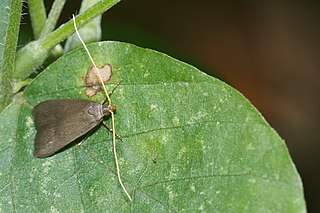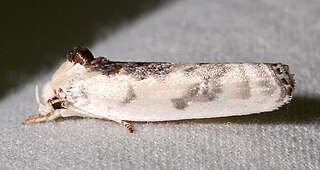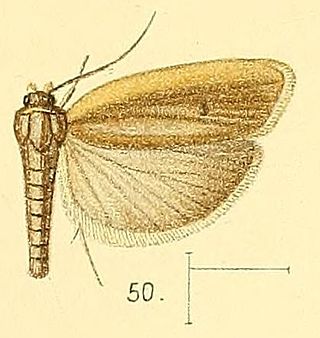Compsolechia is a genus of moths in the family Gelechiidae.

The Lecithocerinae are a subfamily of small moths in the family Lecithoceridae. They are found worldwide, but most species occur in South Asia. The subfamily is characterized by the male genitalia with a bridge-like structure connecting the tegumen and the valva, and the uncus almost always is vestigial with two lobes at the dorsal base, only exceptionally united into a broad plate, but never as a thorn or spine.

Antaeotricha is a genus of moths. It is the largest genus in the subfamily Stenomatinae, numbering over 400 species in the Western Hemisphere.

Stenoma is a genus of moths. The type species is Stenoma litura, which was described by Philipp Christoph Zeller in 1839.
Anadasmus venosella is a moth in the family Depressariidae. It was described by Francis Walker in 1864. It is found in Amazonas in Brazil and in Bolivia.
Antaeotricha filiferella is a moth in the family Depressariidae. It was described by Francis Walker in 1864. It is found in Amazonas in Brazil and in Panama.
Antaeotricha reductella is a moth in the family Depressariidae. It was described by Francis Walker in 1864. It is found in Amazonas, Brazil and in French Guiana.
Cerconota recurvella is a moth in the family Depressariidae. It was described by Francis Walker in 1864. It is found in the Guianas, Colombia and Tefé, Brazil.
Stenoma dispilella is a moth in the family Depressariidae. It was described by Francis Walker in 1866. It is found in Colombia.
Stenoma consociella is a moth in the family Depressariidae. It was described by Francis Walker in 1864. It is found in Suriname, Guatemala, Panama and Brazil (Amazonas).
Stenoma ferrocanella is a moth in the family Depressariidae. It was described by Francis Walker in 1864. It is found in Panama and Brazil (Amazonas).
Stenoma lucidiorella is a moth in the family Depressariidae. It was described by Francis Walker in 1864. It is found in Colombia, Brazil and French Guiana.
Stenoma ovatella is a moth in the family Depressariidae. It was described by Francis Walker in 1864. It is found in Brazil (Amazonas) and Colombia.
Stenoma pustulatella is a moth in the family Depressariidae. It was described by Francis Walker in 1864. It is found in Brazil.
Stenoma scitiorella is a moth in the family Depressariidae. It was described by Francis Walker in 1864. It is found in Panama, Brazil (Amazonas) and Guyana.
Stenoma straminella is a moth in the family Depressariidae. It was described by Francis Walker in 1864. It is found in Amazonas, Brazil.
Stenoma strenuella is a moth in the family Depressariidae. It was described by Francis Walker in 1864.
Stenoma subnotatella is a moth in the family Depressariidae. It was described by Francis Walker in 1864. It is found in Ega, Brazil.
Stenoma xanthophaeella is a moth in the family Depressariidae. It was described by Francis Walker in 1864. It is found in Amazonas, Brazil.


